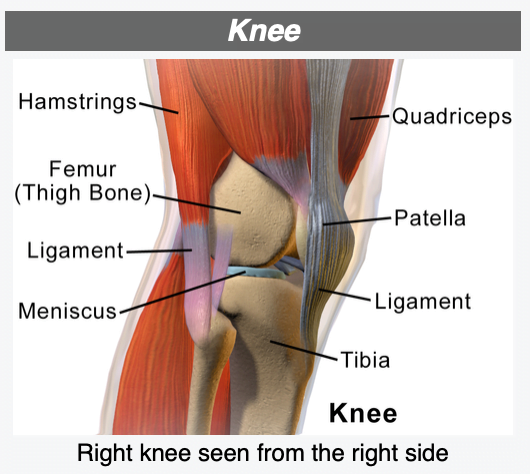The knee is one of the most common body parts to be injured. Types of common knee injuries include sprains, strains, bursitis, dislocations, fractures, meniscus tears, and overuse injuries
In this blog, I will be sharing my personal experience on meniscus tear and the challenges I went through post surgical and to some extent till present and how Yoga is helping me to increase my body awareness especially in movement and daily workout activities using knee joint e.g compound movements etc.
Introduction to the Knee
The knee is the largest joint in the body. The knee allows the leg to bend where the femur (thighbone) attaches to the tibia (shinbone). The knee flexes and extends, allowing the body to perform many activities, from walking and running to climbing and squatting. There are a variety of structures that surround the knee and allow it to bend and that protect the knee joint from injury.
What muscles are responsible to move the knee?
The quadriceps and hamstring muscles are responsible for moving the knee joint. When the quadriceps muscles (located on the front the thigh) contract, the knee extends or straightens. The hamstring muscles, located on the back of the thigh, are responsible for flexing or bending the knee. These muscles are also important in protecting the knee from being injured by acting to stabilize the knee and preventing it from being pushed in directions that it isn’t meant to go
Liagaments
There are four ligaments that also stabilize the knee joint at rest and during movement: the medical and lateral collateral ligaments (MCL, LCL) and the anterior and posterior cruciate ligaments (ACL, PCL).


Knee Cartilage & Meniscus
Cartilage within the joint provides the cushioning to protect the bones from the routine stresses of walking, running, and climbing. The medial and lateral meniscus are two thicker wedge-shaped pads of cartilage attached to top of the tibia (shin bone), called the tibial plateau. Each meniscus is curved in a C-shape, with the front part of the cartilage called the anterior horn and the back part called the posterior horn.
There is also articular cartilage that lines the joint surfaces of the bones within the knee, including the tibia, femur, and kneecap

What is a torn meniscus
A torn meniscus is damage from a tear in the cartilage that is positioned on top of the tibia to allows the femur to glide when the knee joint moves. Tears are usually described by where they are located anatomically in the C shape and by their appearance (for example, “bucket handle” tear, longitudinal, parrot beak, and transverse) to determine if it is medial or lateral meniscus.
What causes meniscus to tear?
A forceful twist or sudden stop can cause the end of the femur to grind into the top of the tibia, pinching and potentially tearing the cartilage of the meniscus. This knee injury can also occur with deep squatting or kneeling, especially when lifting a heavy weight. Meniscus tear injuries often occur during athletic activities, especially in contact sports like football and hockey.
Motions that require pivoting and sudden stops, in sports like tennis, basketball, and golf, can also cause meniscus damage. The sports injury does not have to occur during a game but can also occur in practice, where the same motions lead to meniscus damage.
Age plays a part
The risk of developing a torn meniscus increases with age because cartilage begins to gradually wear out, losing its blood supply and its resilience. Increasing body weight also puts more stress on the meniscus. Routine daily activities like walking and climbing stairs increase the potential for wear, degeneration, and tearing. It is estimated that six out of 10 patients older than 65 years have a degenerative meniscus tear. Many of these tears may never cause problems.


Me and my Right lateral meniscus tear experience
I personally underwent surgery to repair my torn right lateral meniscus 5 years ago and since then it has never been the same. I was involved in an intense week of high volume performance training in New Zealand and it involved repetitive weight bearing barbell exercises.
Prior before the trip, my training was HVIT (high volume intensity training) for couple of months and I believed that with the accumulation of stress and could have been more of mobility and stretch led to the sudden pop.
Ever since the surgery, there is always occasional swelling and tightness around my right knee. Range of motion decreases by 10-20%. Post surgery also caused quite a fair amount of scar tissues.
Does it impact my training?
It doesn’t impact my training but I am more mindful and take extra time pre-training to activate my Vastus Medialis Oblique (VMO)
It is one of four quadriceps muscles which sits medially or on the inside of our thigh. Its primary function is to extend the knee.
In Yoga class :
Due to the wear and tear of my lateral meniscus, I personally find it challenging to be in any poses requiring bending my knees fully especially in seated postion for example :
- thunderbolt pose, Vajrasana variations
- recline hero pose, Supta Virasana and variations
- Lotus pose, Supta Ardha Padmasana



Conclusion
Staying mindful, be patient and keep trying. My aim is to work towards mobility of knee joint through Yoga and work towards the day when I can slowly get into lotus pose.


